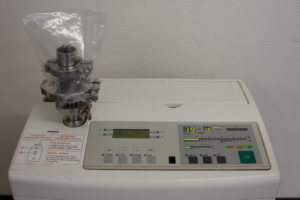Leak Testing a Feedthrough
It is important to measure the hermeticity (the state of being sealed airtight) of seals to check the effectiveness of the seal. The three common methods used in the hermetic manufacturing industry are bubble test, pressure decay, and helium leak detection. Helium leak detection is accepted as the best test method for determining the fine leak rate across most industries.
Bubble testing is good for proof testing an assembly and for finding medium to gross leaks. Of the three methods listed in this article bubble testing requires the least amount of equipment, could be as simple as a fixture to hold the part and shop air from your air compressor. Bubble testing is not practical for fine leaks due to the time it would take for a bubble to form from a fine leak. A fine leak could take hours or weeks for even the smallest bubble to form. Another problem with bubble testing is that it can be subjective and the person doing the test could easily miss a slow leak. Sometimes a combination of test methods can be used. For example, high pressure bubble test then a helium leak detector test or a high pressure helium leak detector test.
Pressure decay tests can be used for determining a large range of leak rates. This type of testing requires some specialized equipment but can typically be done for cheaper than helium leak detection. Many factors must be considered when developing a specification for pressure decay testing. Chamber volume and temperature can easily skew the results from one test to another. The time required to get results on slower leaks is another reason why most people prefer and use the helium leak testing method.
Fine leak tests are commonly performed by measuring the rate at which the seal leaks helium. This method uses a mass spectrometer that is calibrated for helium. The hermetic seal to be tested is placed in a port on the helium test equipment and a vacuum is pulled on one side of the test part while the non-vacuum side is flooded with helium. Then, the mass spectrometer measures the leak rate by detecting the release of helium.
If a part passes a leak test it is called hermetic (typically 1X10^-7 std-cc/sec); however, if it fails, it is known as a “leaker” and will not be sent as is. For a basic understanding, leakage is commonly measured as std-cc/sec, which is cubic centimeters per second and a 1 atmosphere pressure differential. The table below breaks down leak rates. Note the range of leaks that are measured. Some seals may leak one cubic centimeter per ten seconds (that’s a lot!), but some hermetic seals can be sealed so well that they only leak a cubic centimeter once every three thousand years! That means if a seal were created in 2019, only one cubic centimeter of helium would leak by 5019.
If you have any questions or concerns, please call us at 888.747.3250 x4, or email us at [email protected].
| Std cc/sec Approximate | Approximate Bubble Equivalent |
| 1 x 10^-1 | 1 cc/10 sec |
| 1 x 10^-2 | 1 cc/100 sec |
| 1 x 10^-3 | 1 cc/1 hour |
| 1 x 10^-4 | 1 cc/3 hours |
| 1 x 10^-5 | 1 cc/24 hours |
| 1 x 10^-6 | 1 cc/2 weeks |
| 1 x 10^-7 | 3 cc/1 year |
| 1 x 10^-8 | 1 cc/3 years |
| 1 x 10^-9 | 1 cc/30 years |
| 1 x 10^-11 | 1 cc/3000 years |

Leak testing a hermetic USB feedthrough at RHSeals.

